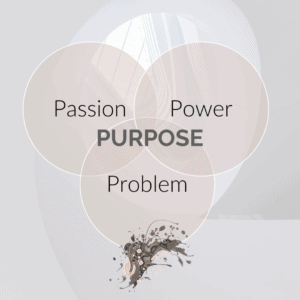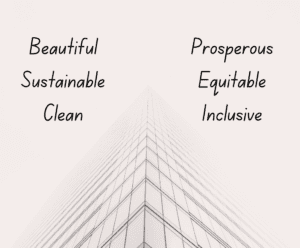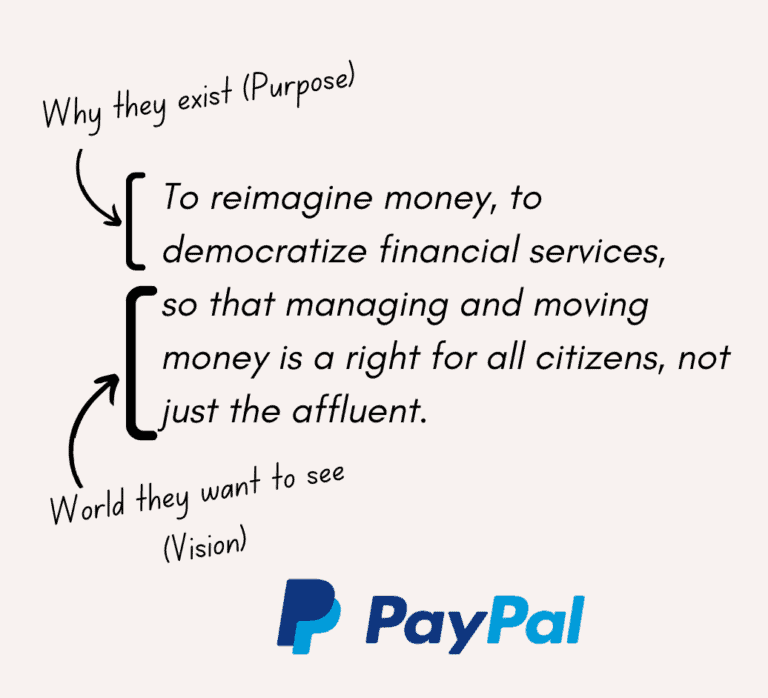Many self-proclaimed Purpose-driven businesses have not articulated their Purpose in a single statement. Follow this guide and use the workbook to craft a statement that generates clarity, loyalty, and impact.
Why Having A Purpose Statement Is So Important
A Purpose statement is a critical foundation for Purpose-driven businesses.
It describes your reason for existing: the ultimate impact you want to have on the world in one compelling sentence.
But many Purpose-driven businesses have not articulated their Purpose in a statement, or it lacks critical elements.
Why is it so important to have a well-written Purpose statement?
The sheer process of writing a Purpose statement will lead you and your team to an unparalleled level of clarity about why you are in business.
First off, the sheer process of writing a Purpose statement will lead you and your team to an unparalleled level of clarity around why you are in business.
You may think you know what your Purpose is, but until you’ve done the work to sum it up in one sentence, you can’t be certain.
Secondly, even if you’re certain you know what your Purpose is, a Purpose statement ensures your stakeholders – your employees, your suppliers, investors and customers – clearly understand what it is.
It will attract those who believe it is a worthy Purpose to pursue. Because they believe in it too, they’re going to be loyal and they’re more liklely to want to be involved in your journey.
If you already know what your company’s Purpose is (see the ‘Find Your Purpose Guide‘ if you need help finding it), but you haven’t spent time writing or polishing it in one statement, read on for the top 5 characteristics to include as you write a powerful Purpose statement.
How to Write a Powerful Purpose Statement - Free Workbook
You’ll also receive a quick and snappy digest with the latest news and events to help grow your impact. Unsubscribe any time.
How A Purpose Statement Differs from a Mission and Vision Statement
Before we talk about writing a Purpose statement, let’s clarify what it is not.
A Purpose statement is different from a Vision and Mission statement:
A Vision statement describes what the world would look like if you achieve your Purpose.
A Mission statement describes how you will get from your Purpose to your Vision.
Your means of getting there (your Mission) may vary and evolve over time. But your Purpose and Vision should stay the same, at least in essence.
You may find that your Purpose leads you to evolve & transform your business in ways you never imagined. This is fine as long as it makes good business-sense in terms of profitability, and the resources and assets you have at your disposal.
In fact, from a business perspective, transformational growth (as opposed to simply linear) is one of the most exciting and powerful outcomes of being a Purpose-driven business.
Mission → Purpose → Vision
A Powerful Purpose Statement Has These 5 Characteristics
Having a Purpose statement is good, but having a powerful Purpose statement will give you clarity, help you build a Purpose-oriented culture, generate loyalty, and inspire aligned action across the organization.
What takes a Purpose statement from good to powerful? It has the following 5 characteristics:
1. It reflects the overlap between your Passion, your Power and a relevant societal Problem
This is covered in a lot more depth in the ‘Find Your Purpose Guide’.

Passion – It is essential that you and your staff have an emotional connection to your Purpose in that it is rooted in the company’s values and beliefs. In other words, you and your staff must be passionate about it. If not, you, or your staff, will lose interest in it over time because you aren’t intrinsically motivated to pursue it.
Power – Additionally, it must be strategically connected to your core business, in terms of what you do well and what earns your Business a profit: this is your power.
If it is not connected to what you do well, you are unlikely to generate the profits necessary to fund meaningful progress towards your Purpose.
You will also struggle to make it the focal point of your business and this will severely hamstring your impact.
Problem – Thirdly, your Purpose must focus on one or more societal problems.
This is what ultimately differentiates Purpose-driven businesses from traditional businesses: they exist to benefit society.
To do so efficiently and effectively, you must be clear about which societal problem(s) you are addressing.
In sum, your Purpose lies at the intersection of what you are passionate about, what your business is good at, and a relevant societal problem. See Venn diagram above.
Indeed, this is where you are uniquely positioned to make an impact.
2. It addresses a significant societal problem.
Your Purpose statement must reflect an intent to help solve, or make a sizeable impact on, a significant social or environmental challenge. If you’re not sure whether it would be considered a significant problem, look for it somewhere within the UN’s Sustainable Development Goals (SDGs). This assures you that it is a universally agreed upon, serious problem.
For example, you won’t find ‘improved productivity’ anywhere in the SDGs. Yes, improved productivity might benefit society, but it is not considered a significant societal problem.
By reflecting the pursuit of a significant societal problem, your Purpose statement will attract, inspire and motivate employees, customers, and investors who believe in its worthiness.

3. It must be outcome-oriented.
Your Purpose statement is not a description of what you do.
Rather, your Purpose statement should communicate your role in working towards a particular result.
For example, “we build water sanitation technology” addresses a significant societal problem, but it describes what you’re doing, rather than the – much more compelling – reason why you’re doing this work.
What result are you pursuing? To limit disease transmission? To improve health outcomes in rural areas? Reduce infant and child mortality? Clarifying your why could take your business in dramatically different directions.
4. Your Purpose statement should reflect a long-term, aspirational quest.
A Purpose statement should, ideally, last for the lifetime of your business. This will ensure it is highly ambitious and aspirational.
Why does this matter?
Because meaningful change takes time, and even if it is achieved, it will require effort to sustain it.
If you are serious about creating meaningful impact, you need to be in it for the long haul. For example, yes “building a daycare for under-privileged children” is a benefit to society, but it is not a long-term pursuit.
5. It should be clear and concise.
This may be obvious, but your Purpose statement needs to be easily understood by all your stakeholders. This is why you want to aim for one sentence, while avoiding the risk of being too vague. Being clear and concise is often a challenging task, but the process of working towards it will be a valuable one, I assure you.
If the Purpose statement reflects all of these characteristics, it is likely to be an incredibly powerful one.
By reflecting the pursuit of a significant benefit to society, your Purpose statement will inspire and motivate employees, customers, and investors who believe in its worthiness.
How to Write a Purpose Statement: Breaking Down the Grammatical Elements
Most powerful Purpose statements can be broken down into 3 grammatical parts:
- A transitive verb
- An adjective
- An object
Yes, I’m asking you to think all the way back to grammar class, but I’ll help refresh your memory.
A transitive verb describes the action you are taking on something. In the image on the left, you’ll see examples of transitive verbs:
Transitive Verbs

Adjectives

Adjectives are used to describe the object. They aren’t always necessary to include, but you can insert an adjective to help describe the kind of results you want to see. See examples of adjectives in the image.
Finally, what is the object you’re seeking to affect? Is it forests? The Ocean? The planet or world as a whole? Children? A particular illness? A particular social issue, such as gender inequality or financial exclusion?
The final Purpose Statement will look something like this:
We exist to [transitive verb] a [adjective(s)] [object].
You can see why some companies decide to combine their Vision statement with their Purpose statement. Sometimes the final part of the Purpose statement describes the world they want to see!
For example, Paypal’s Purpose statement includes both (see image).

Some opt not to have a Vision statement at all, and I don’t believe it’s entirely necessary.
For example, Patagonia’s Purpose statement includes their role in bringing about a clear societal benefit, but it does not completely describe what the world looks like if they achieve it:


This is similar to Tesla. It is answers why they exist, it is aspirational, outcome-oriented, and it is most certainly clear and concise. However it does not describe what the world looks like if they achieve it:
Test It, Before You Fly It
Ideally, your Purpose statement will last the lifetime of your company.
You want to get this right.
Follow the guidance laid out in this post, and download the workbook to test it against the 5 characteristics of powerful Purpose Statements.
Take it to your team or trusted partners, investors, and even a focus group of customers, to gather their input and feedback.
Make any final adjustments, and you’ll be ready to share your Purpose statement with the world.
Stay tuned – my thoughts on how, when and where to talk about it will be coming soon!
How to Write a Powerful Purpose Statement - Free Workbook
You’ll also receive a quick and snappy digest with the latest news and events to help grow your impact. Unsubscribe any time.
Remember, A Purpose Statement is Not a Marketing Tactic
It is worth stating that the company’s Purpose must be an authentic & serious pursuit for the company.
A Purpose statement does not automatically make you a Purpose-Driven business. Your Purpose must be embedded into the core strategy and operations of your business.
Those in positions of leadership must be undeniably committed to working towards this Purpose. Yes, you will need all your employees to stand behind it if you want to see significant results, but without an authentic commitment at the top, it will most certainly fall flat.
This means that the company’s leadership will be guided by the Purpose Statement when faced with decisions and trade-offs, large and small. Leaders should be held accountable for working towards it, and, ideally, even your staff’s contributions should be measured as part of their performance review.
Reach out today to discuss developing a comprehensive Purpose strategy.
Acknowledgments
Based on my extensive experience developing Purpose, mission and vision statements for both Businesses and Non-profits, and inspiration from FSG, the United Way Social Purpose Institute, and Phil Preston.
Did You Like This?
Help create a world where businesses are part of the solution. Share it here →


